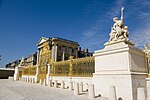Hôtel de la Guerre

The Hôtel de la Guerre (literally the 'Hotel of the War') also known as Carnot Barracks is the name of a building located at 3, Rue de l'Indépendance-Américaine in Versailles, built near the Palace of Versailles. The building was built in 1760 by Jean-Baptiste Berthier, father to the later famed Marshal Louis-Alexandre Berthier, to bring together the different war offices into one central location (until then, they had been dispersed in Paris, notably at the Bastille and Hôtel de Ville). The building was one of the first buildings built in France which was designed to be 'fire proof' and 'limited the risks of a fire'. The building currently houses the Central Directorate of the Defence Infrastructure Service, part of the French Army. The building's massive entrance was classified as a historical monument on 1 September 1922, followed by the façade on the street side and roof, classified on 16 September 1929.
Excerpt from the Wikipedia article Hôtel de la Guerre (License: CC BY-SA 3.0, Authors, Images).Hôtel de la Guerre
Rue Saint-Julien, Versailles
Geographical coordinates (GPS) Address Nearby Places Show on map
Geographical coordinates (GPS)
| Latitude | Longitude |
|---|---|
| N 48.8025 ° | E 2.1213888888889 ° |
Address
Direction Centrale du Service d'Infrastructure de la Défense (DCSID)
Rue Saint-Julien
78000 Versailles, Saint-Louis
Ile-de-France, France
Open on Google Maps










